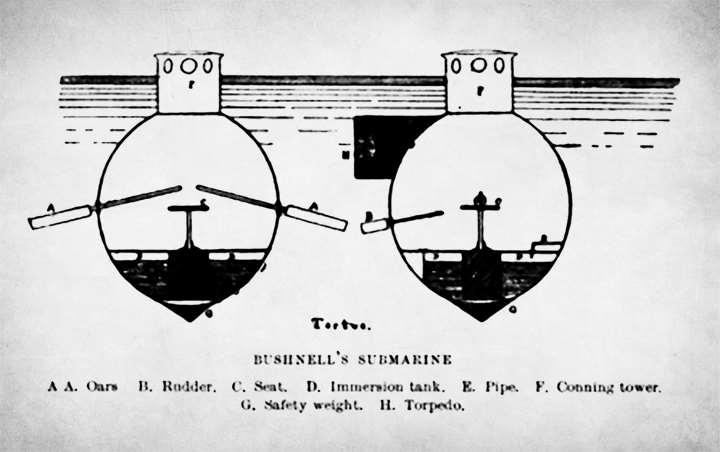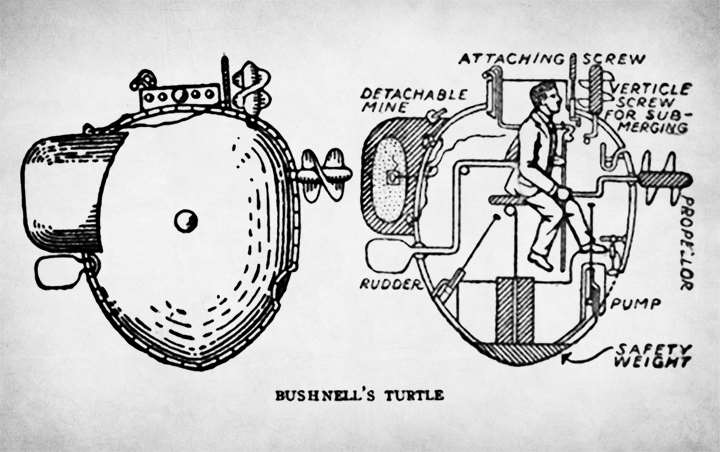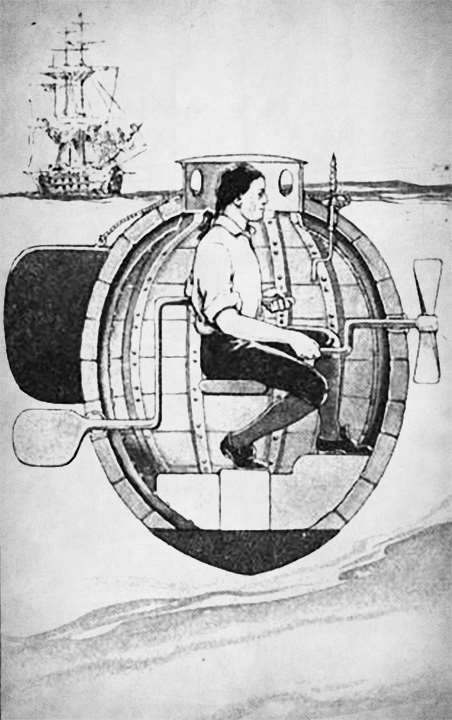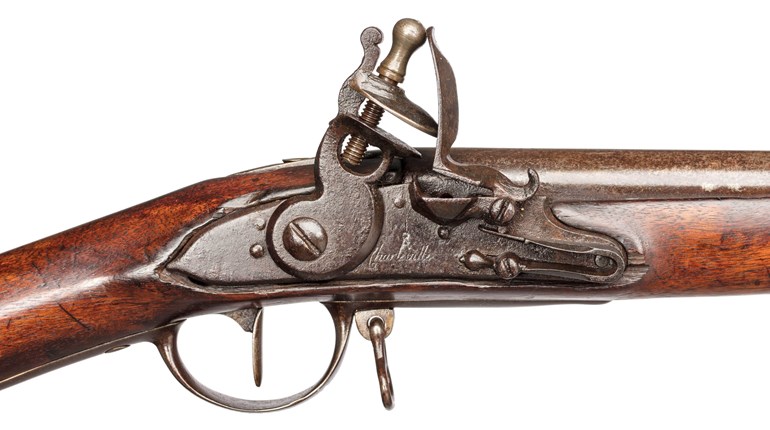
Facing by far the most powerful navy of the day, it is no wonder that the tiny Continental Navy—barely a year old—had to rely on imagination and outsized courage in those early days. Two hundred forty years ago this week, it did both in launching the first attack by a submerged vessel. It was decidedly audacious; auspicious, not so much.

It is correct to observe that militaries had long used underwater measures against one another. Even the invention of the submarine, however loosely defined, preceded the deployment of the minuscule Turtle against the 64-gun flagship of British Vice Admiral Lord Richard Howe by several hundred years. Historical records refer to diving exploits during the siege of Syracuse (415 B.C.), and reconnaissance by no less than Alexander the Great during his siege of Tyre in 332 B.C.
But a recognizable conception of a maneuvering, surface-independent underwater warship would wait many centuries. Leonardo da Vinci expounded a rough version in notes he long kept secret in the late 1400s, and Englishman William Bourne actually advanced to a workable plan a century later. Dutch inventor Cornelius Drebbel built a successful prototype for James I of England in the 1620s, though his craft did not appear to achieve “neutral buoyancy,” the hallmark of the true submarine that allows it to rise or descend as commanded or propelled.
The Turtle of 1776 was therefore primitive and modern at the same time. Its name derived from two vaguely hemispheric wooden halves covered with tar for waterproofing, and bound together by metal hoops. The brainchild of framer, patriot and Yale student David Bushnell, the proposed use went hand-in-hand with another invention of his—a workable underwater explosive.

The plan was for the one-man, 10-foot-long, 6-foot-tall, and 3-foot-wide Turtle to be towed as close to a target vessel as feasible, and then released. Using a hand-cranked and treadle-operated propeller and a hopefully advantageous tide, it would maneuver toward the target mostly submerged—only a small “conning tower” and snorkels would remain above water—and then dive for the actual attack. Once underneath the target, the scant 20- to 30-minute air supply meant that drilling into the enemy hull (via the hand-turned bore mounted through the Turtle's hull), the attachment of Bushnell’s 150-pound blackpowder “mine,” and the getaway had to proceed before carbon dioxide poisoning overtook the operator. Connecticut clockmakers Isaac Doolittle and Phineas Pratt had modified both a clock and flintlock mechanism at Bushnell’s behest to give time enough to escape the blast.
In execution, the plan to sink Howe’s HMS Eagle as she lay moored in New York Harbor did not go nearly so well. Bushnell’s brother, Ezra, who had conducted most of Turtle’s tests was taken ill, and was replaced by volunteer Ezra Lee. Undaunted by his relative inexperience with the completely new technology, Lee was towed into position, and bobbed for two hours, station-keeping until near dawn when the tide turned in his favor. He maneuvered under the Eagle as planned, but was twice thwarted in attaching the mine. (Explanations vary as to why, though David Bushnell speculated on the bad luck of hitting an iron plate associated with the rudder on the first attempt, and exhaustion and CO2 inhalation by the time of the second.)
Lee released the torpedo (he may have coined the enduring term) when a British boat rowed out from nearby Governor’s Island after dawn to investigate the now-visible Turtle. British caution thwarted this alternative plan, however; while Lee reported a successful detonation of “tremendous violence” in the East River, there was no damage to any British vessel.

Bushnell’s Turtle was destined to a short career, despite its relative—and at the time, unique—technology. Ezra Lee attempted another attack the following month on a Royal Navy frigate anchored off Manhattan, but this too was unsuccessful. Shortly thereafter, the Turtle’s tender was sunk in the Hudson off of New Jersey’s Ft. Lee. Though Bushnell reported salvaging the Turtle, she was never used in combat again, and disposition after October 1776 remains unknown.
Naval powers the world over were paying attention, however. While materials, propulsion and breathable air for the crew were stubborn problems, the advantages of undetected maneuver over seven-tenths of the globe’s surface held undeniable appeal. Advances at first were slow, though American ingenuity fueled many of them: H.L. Hunley would finally inflict the first submarine sinking in 1864, when the Confederate privateer sank the USS Housatonic in Charleston Harbor, S.C.
World War I would see submarine activity burgeon on a huge and deadly scale. Diesel/electric British and German submarines would extensively harass each other’s surface shipping throughout the war, but the sinking of the RMS Lusitania by German Unterseeboot U-20 in May, 1915, would later be seen as the beginning of the end of American neutrality in the conflict.
By the onset of World War II, all (eventual) major combatants would field large numbers of submarines. German submariners earned a ferocious and deadly reputation early on, sinking roughly one quarter of all U.S. and Canadian aid sent to allied England before German losses became unacceptable by the end of 1943. In what English Prime Minister Winston Churchill dubbed “The Battle of the Atlantic,” 3,675 Allied merchantmen and warships went to the bottom of the Atlantic, along with 783 U-boats.

The advent of nuclear power was surely the biggest game-changer in the history of submarines, and one pioneered—again—by American innovation. Beginning in the 1950s, submerged endurance became essentially unlimited; without the need for combustion or breathable air (“nukes” did not need the first, and could perpetually manufacture the second), patrols were limited only by food stores. Fast, quiet and huge by even World War II standards, the roles of the submarine expanded markedly too, with submerged-launch conventional and nuclear weapons extending their reach well beyond the merely nautical antagonists of yesteryear.
Some observers have also suggested the end of the Cold War was made possible by submarine technology and the efforts of the Silent Service. The U.S. lead in stealth and precision allowed American submariners to form the third leg of the so-called “Nuclear Triad” (of land-based, air-dropped and sea-launched nuclear weapons). Matching this technology became impractical in the former Soviet Union by the late 1980s for a host of reasons, and contributed to the behemoth’s dissolution.
That’s a long convoluted walk—or swim—to be sure, from David Bushnell, Ezra Lee and the diminutive Turtle.


































